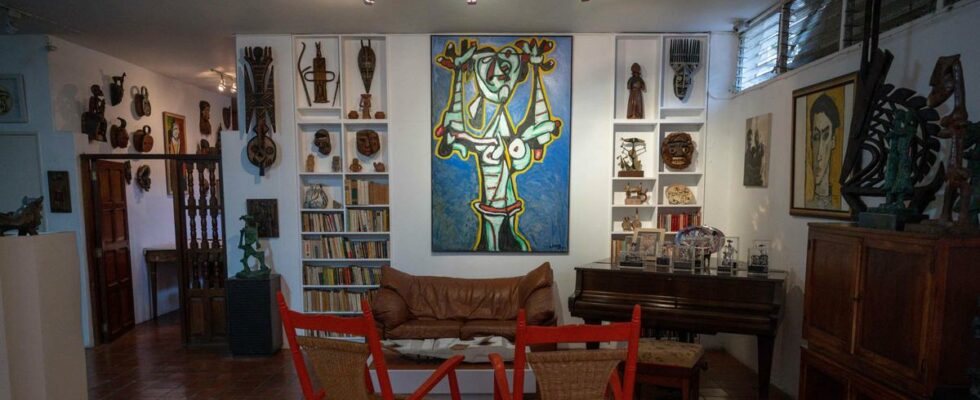The catalog raisonné, launched this year for the centenary of his birth, traces the prolific career of the Venezuelan painter. For the occasion, AFP was able to enter its lair.
A table as a palette. Oswaldo Vigas (1923-2014), whose abundant work is exhibited in museums and galleries around the world, mixed his colors directly on the furniture of his studio in Caracas.
Over the years, the layers of paint have piled up to reach several centimeters. Around the work table, in this still intact workshop that the family recently opened to AFP, three paintings are installed on easels. One is a magnificent crucifixion”pop» green and pink with the characteristic shapes of Vigas. It is one of his last paintings, according to his son, director Lorenzo Vigas, Golden Lion of Venice with The lovers of Caracas (2015). “We haven’t touched anything. We left it as it wasbefore his death, he explains.
Like Picasso, whose photo with Vigas hangs on a wall, the Venezuelan painter was a workaholic and experienced different periods, sometimes radically changing his style. “He worked at night until five or six in the morning. He got up late. The night was for his artrecalls Lorenzo.
The catalog raisonné, launched this year for the centenary of his birth, traces Vigas’ prolific career. Sixteen years of work were necessary to identify the 4000 works of the artist which “painted, painted, painted“. This catalog is a first for a Venezuelan painter. Thus, there are no complete ones for the famous Carlos Cruz-Diez, Jesus Soto, Armando Reveron or Manuel Cabré.
“A social animal”
“We couldn’t have done it without him. My father was a very orderly artist, who throughout his life accumulated information about the works he sold», Underlines Lorenzo. This allowed the Oswaldo Vigas Foundation to list its production in detail. The catalogue, available for free on the internet, will make it possible to better distribute his work throughout the world, but also to fight against the innumerable counterfeits of the artist whose paintings sometimes sell for hundreds of thousands of dollars. The workshop also allows you to understand the life of the painter. A large space welcomed its many visitors. “He was a social animal. He needed to see people“, points to his son.
Janine, his 87-year-old French widow, remembersparties and concerts. Many, many people came“. On the walls, photos recall this very active social life. For each of them, Janine, whom Vigas met during her Parisian period in the 1950s-60s, has an anecdote. She recounts the image of a shirtless Picasso and her husband, which predates their passion:All South American artists dreamed of meeting Picasso. Oswaldo conquered his daughter Maya (who died in December 2022). Maya fell in love with Oswaldo and he was able to convince herto help her meet him, she said.
Read alsoMaya Ruiz-Picasso: The Minotaur’s Beloved Muse
The Colombian painter Fernando Botero, the Cuban Wifredo Lam, the French critic Gaston Diehl are also on the walls. Janine then evokes with nostalgia a Parisian image: Vigas playing maracas behind the other Venezuelan painters Jesus Soto on the guitar, Elbano Mendez Osuna on the mandolin and Jesus Hurtado. “It was a good time. We had a lot of fun“, she says.
Pre-Columbian roots, contemporary work
In the other room of the workshop, an impressive collection of pre-Columbian art and African masks. Another point in common with Picasso. “Back then you could buy things at flea marketsfrom Saint-Ouen to Paris, says Janine. “We also came to offer him works. He said to me “Have you seen how beautiful it is? How much do we have (money) left?” And he almost always ended up buying“. “He was obsessed with wanting to be surrounded by works from the past, not just pre-Columbian, but also African. My father is the first Venezuelan who was able to do a contemporary work while taking primitive elements from the country», assures Lorenzo, evoking in particular the series of Brujas (witches) which constitutes a pivotal part of his work.
Originally from Valencia (central north), “my father traveled all over the country looking for pre-Hispanic Venezuela, the petroglyphs (some of which can be seen in the museum of Caracas). He went to see the paintings that the Amerindians made on their faces… It was decisive. He found his roots. It was after this trip that he began to develop his work which was contemporary but came out of the past.“says Lorenzo. He also explains the return of Vigas after a dozen successful years in France by this “connection with his land which was very strong. He needed to be here to create.»
Today, the foundation tries to make Oswaldo Vigas better known. “Since my father was never interested in promoting his work during his lifetime, this promotion is up to us.says Lorenzo,But, it’s moving to see that there are people who discover and are passionate about him.»
